Kitchen
DIY Butcher-Block Countertop Restoration Tips
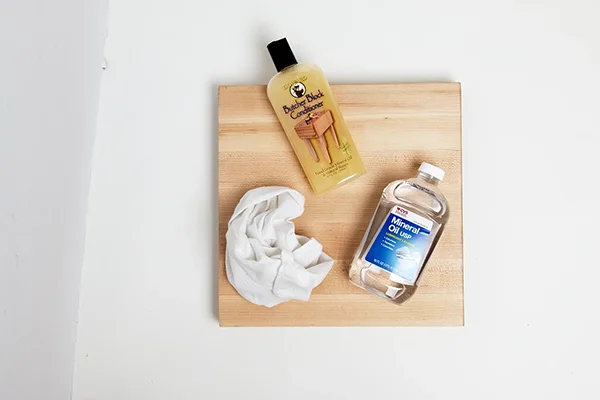
Butcher Block Restoration Tips for a Beautiful, Long-Lasting Countertop
Butcher block countertops add natural charm, warmth, and a timeless look to your kitchen. However, they need regular maintenance and care.
Over time, scratches, water stains, burns, and cracks can damage the surface. But don’t worry—you can fix this easily.
This guide covers essential Butcher Block Restoration Tips and teaches you how to renew your surface step by step.
Tools and Supplies You’ll Need
Before you begin, gather the necessary materials. Having everything ready ensures a smooth, efficient butcher block restoration project from start to finish.
Essential Tools
- Nitrile gloves
- Medium-grit sandpaper
- Microfiber cloth
- 6-inch random orbital sander
- 5-in-1 painter’s tool
- Nylon scrub brush
- Sponge
Cleaning Agents and Finishes
- Food-safe wood oil or conditioner
- Hydrogen peroxide (3%)
- Powdered oxygen bleach
- Beeswax and mineral oil blend
- Canning wax
Step-by-Step Butcher Block Restoration Tips
Follow these Butcher Block Restoration Tips carefully to bring back the beauty and function of your countertop.
Step 1: Clean and Disinfect Thoroughly
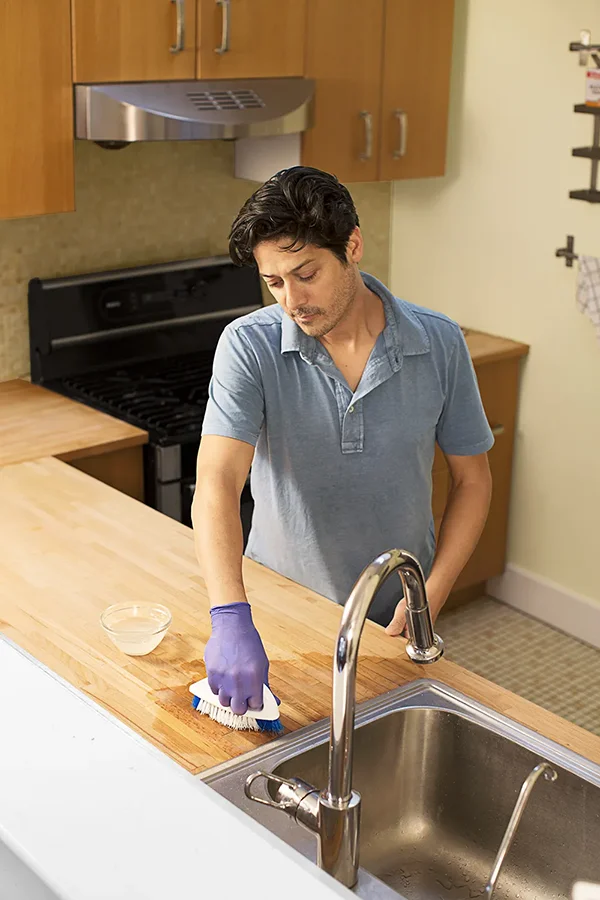
Start with a clean surface. Remove all dirt, grease, and stains so restoration products can work effectively on clean wood.
Remove Dirt and Grime
Use a damp microfiber cloth to wipe the surface. Scrub gently with mild soap and a nylon brush for stubborn grime.
Treat Mold, Mildew, and Stains
Mix oxygen bleach in hot water and scrub mildew spots with a stiff brush. Rinse well and allow it to dry.
For wine stains, dab with hydrogen peroxide using a cotton swab. Wipe clean with a damp cloth and repeat if needed.
Step 2: Sand the Surface Properly
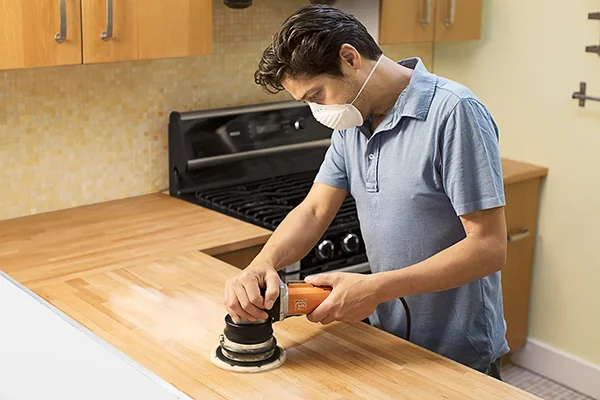
Once clean and dry, sand the entire surface. This step removes blemishes and prepares the wood for sealing and finishing.
Begin with 60-grit sandpaper to level rough spots. Move on to 100-grit, then finish with 150-grit for a smooth surface.
Always follow the wood grain for the final sanding strokes. This creates a uniform finish and avoids scratching the wood.
Step 3: Fill Cracks and Apply Sealant
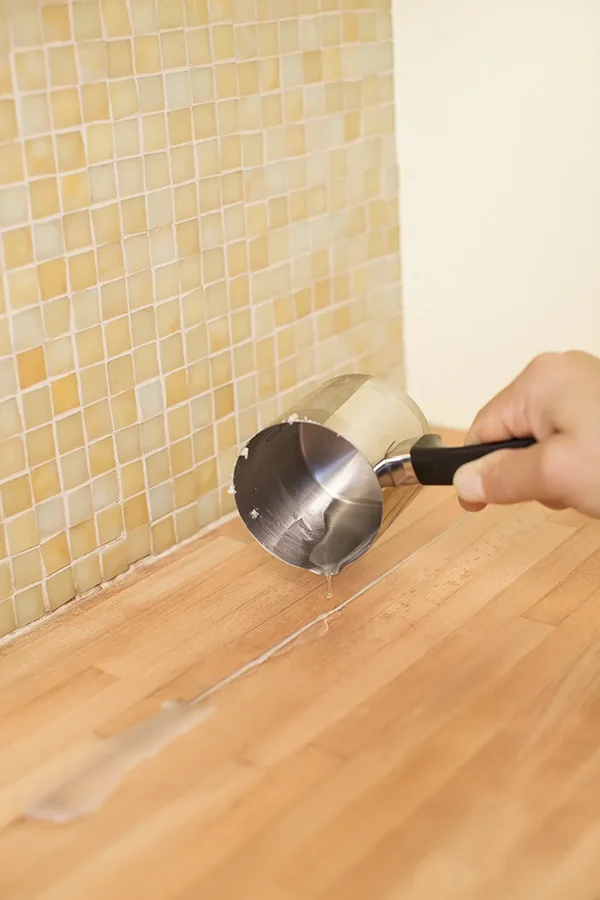
Melt canning wax and pour it into visible cracks. Once it cools slightly, scrape off the excess with your painter’s tool.
Apply a generous amount of butcher block conditioner. Rub it in using a lint-free cloth, then buff after 20 minutes.
This conditioner seals the wood, adds shine, and protects it from moisture. Reapply every few weeks to maintain durability.
Step 4: Finish and Protect the Surface
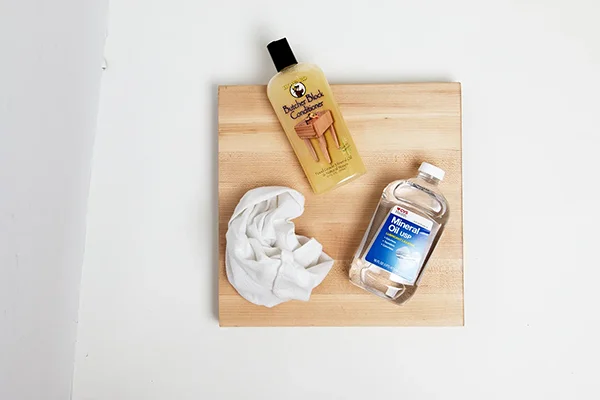
For a safe, effective finish, use food-safe oils or waxes. These products are easy to apply and enhance wood appearance.
Mineral oil works well but wears off quickly. For better results, choose a beeswax and oil blend with water-resistant properties.
Avoid linseed, olive, or canola oils. These oils can spoil and create unpleasant odors. Also avoid varnishes that chip easily.
Maintenance and Long-Term Care
Proper care helps your butcher block countertop last for years. Routine maintenance is essential for preserving the finish and integrity.
Daily Cleaning Habits
- Clean spills immediately to avoid water damage
- Use a soft sponge with mild soap and water
- Never leave standing water on the surface
- Use cutting boards to protect from knife marks
Regular Maintenance Schedule
Keep your countertop beautiful by reapplying wood oil every 4–6 weeks or when the wood appears dry or faded.
Light sanding and oiling once a year will help remove wear and restore the finish. Inspect for cracks and fix them early.
These Butcher Block Restoration Tips help maintain long-term quality and keep your countertop looking fresh and polished.
Troubleshooting Common Butcher Block Issues
Sometimes, issues still happen. Here’s how to address the most common butcher block countertop problems quickly and effectively.
Water Damage
For minor water damage, dry the surface with towels. Let the wood air dry fully, then sand and re-oil the area.
If warping appears, apply moisture to the concave side. Place heavy weights on the other side and allow it to flatten.
Deep Cracks and Serious Warping
When cracks go deep or the warping is severe, consult a professional. They can resurface or press the board as needed.
Being proactive with care and using these Butcher Block Restoration Tips will help prevent future damage and extend the surface’s life.
Conclusion
Your butcher block countertop deserves proper care to stay beautiful and functional. From cleaning to sealing, each step matters.
Use these Butcher Block Restoration Tips to remove stains, fix cracks, and maintain the surface’s natural warmth and durability.
With routine maintenance, your countertop will look amazing and perform well for many years to come.
Explore more home care news and restoration tips on our website.
